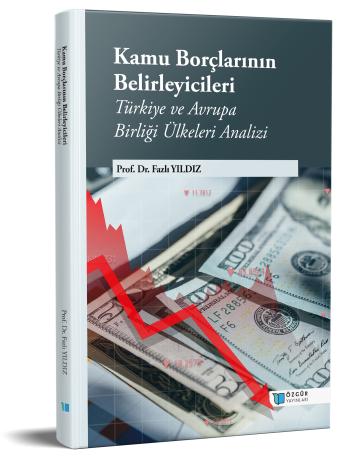
Kamu Borçlarının Belirleyicileri: Türkiye ve Avrupa Birliği Ülkeleri Analizi
İndir
Özet
Kamu hizmetlerinin yürütülmesi amacıyla yapılan kamu harcamalarının öncelikli finansman kaynağı ve devletlerin olağan gelir kaynağı vergilerdir. Vergi gelirlerinin kamu harcamalarının finansmanında yetersiz kalması, devletlerin kamu borçlanmasına (iç ve dış borçlanma) başvurmasına ve para basımı yoluyla kamu hizmetlerinin finansmanını karşılamayı tercih etmelerine neden olmuştur. Kamu borçlanması iktisadi düşünce akımlarının gelişim evrelerinde farklı yönleriyle değerlendirilmiştir. Klasik yaklaşım, kamu harcamalarının finansmanının vergilerle karşılanması gerektiğini savunup borçlanma ile sağlanan gelirleri “olağanüstü gelir” olarak tanımlamışken; özellikle 1929 Büyük İktisadi Buhran sonrası dönemde devletin ekonomiye müdahalesinin artması ve devletin gelir ile giderleri arasında yaşanan dengesizlikler kamu borçlanmasının olağan bir kamu geliri şekline dönüşmesine neden olmuştur. Kamu borçlarının ülkelerde ulaştığı boyut, ülkelerin mali ve ekonomik yapıları üzerinde olumsuz etkide bulunarak, özellikle az gelişmiş ve gelişmekte olan ülkelerde ekonomilerin borç çıkmazı sorunu ile karşılaşmalarına sebep olmaktadır. Yirminci yüzyılın başlangıcından itibaren kamu harcamalarında meydana gelen hızlı artışlar bütçe açıklarının ve dolayısıyla devletlerin borçluluk düzeylerinin artmasına neden olmuştur. Ülkelerin karşılaştığı kalkınma sorunları, ekonomik krizler ve küresel bazı olumsuz gelişmeler (petrol krizi vb.) de devletlerin iç ve dış borçluluk düzeylerini arttırmıştır. Devlet borçlanması, ekonomi üzerinde ortaya çıkaracağı muhtemel olumsuzluklar açısından iyi yönetilmesi gereken alanlardan birisidir.
Kamu borcundaki sürekli artışın taşma noktasına ulaşabileceği bir dönemde borçların ekonomi üzerinde olumsuz bir etki ortaya çıkarması muhtemeldir. Bu çalışmanın bulguları kamu borcunu belirleyen ekonomik, mali ve sosyal faktörlerin (ekonomik büyüme, enflasyon oranı, sabit sermaye yatırımları, cari işlemler dengesi, bütçe açığı, işsizlik oranı, faiz oranı ve yolsuzluk) ekonomi için borç seviyelerini nasıl artırabileceği veya azaltabileceği konusundaki ulusal hükümetlerin, politika yapıcıların ve ekonomik kalkınma planlamacılarının görüşlerini yeniden değerlendirmelerine yardımcı olacaktır. Ayrıca, araştırma sonuçları borçluluk seviyesini hangi faktörlerin belirlediğini tespit ederek mevcut literatüre katkı sağlayacak ve her bir belirleyici faktörün kamu borcu üzerindeki muhtemel etkilerinin belirlenmesine yönelik derinlemesine bir analiz sunacaktır. Kamu borçlarının teorik çerçevesinin ve kamu borçlarının belirleyicilerinin ampirik olarak incelendiği bu çalışma kamu borçlanmasına ilişkin teorik yapıyı geniş bir çerçeveden sunması ve ampirik analiz ile birlikte incelenmesi yönüyle bu alandaki diğer çalışmalardan farklılaşmaktadır.
Bu çalışmada, kamu borçlanmasına ilişkin teorik bilgiler ile Türkiye ve Avrupa Birliği ülkeleri özelinde kamu borçlarının ekonomik, mali ve sosyal belirleyicilerini ampirik olarak incelemek hedeflenmiştir. Bu çalışma dört bölümden oluşmaktadır ve incelenen konu başlıkları şunlardır: Kamu Borçlanma Teorisi, Kamu Borçlarının Yönetimi (Borç İdaresi) ve Kamu Borçlarının Ekonomi Üzerindeki Etkileri, Türkiye’de Tarihsel Süreçte Kamu Borçlarının Gelişimi, Kamu Borçlarının Belirleyicilerine İlişkin Literatür İncelemesi ve 2010-2021 Döneminde Türkiye ile Avrupa Birliği Ülkeleri Özelinde Kamu Borçlarının Belirleyicilerine Yönelik Ampirik Analiz.
Çalışmanın kamu borçlanmasına ilişkin çalışmalar yapan lisans ve lisansüstü öğrencilerine, akademisyenlere ve ilgi duyan araştırmacılara yararlı olması dileğiyle…..

